Picato
HIGHLIGHTS OF PRESCRIBING INFORMATION INDICATIONS AND USAGEPicato ® gel is an inducer of cell death indicated for the topical treatment of actinic keratosis. ( 1 )DOSAGE AND ADMINISTRATION For topical use only; not for oral, ophthalmic, or intravaginal use. ( 2 ) Actinic keratosis on the face and scalp: Apply Picato® gel, 0.015% to the affected area once daily for 3 consecutive days. ( 2 ) Actinic keratosis on the trunk and extremities: Apply Picato® gel, 0.05% to the affected area once daily for 2 consecutive days. ( 2 ) DOSAGE FORMS AND STRENGTHSGel containing ingenol mebutate, 0.015% or 0.05% ( 3 ) CONTRAINDICATIONSNone. ( 4 )WARNINGS AND PRECAUTIONSEye disorders, including severe eye pain, eyelid edema, eyelid ptosis, periorbital edema can occur after exposure. Avoid contact with the periocular area. If accidental exposure occurs, flush eyes with water and seek medical care. ( 5.1 ) Local skin reactions can occur including severe reactions (e.g., vesiculation/pustulation, erosion/ulceration). Administration of Picato® gel is not recommended until skin is healed from any previous drug or surgical treatment. ( 5.2 ) Side EffectsThe most common adverse reactions (≥2 %) are local skin reactions, application site pain, application site pruritus, application site irritation, application site infection, periorbital edema, nasopharyngitis and headache. ( 6.1 ) To report SUSPECTED ADVERSE REACTIONS, contact LEO Pharma Inc. at 1-877-494-4536 or FDA at 1-800-FDA-1088 or www.fda.gov/medwatch.
FULL PRESCRIBING INFORMATION: CONTENTS*
- Principal Display Panel for PICATO [Pih-KAY-toe] (ingenol mebutate) gel 0.015%
- Principal Display Panel for PICATO [Pih-KAY-toe] (ingenol mebutate) gel 0.015% Physician Sample
FULL PRESCRIBING INFORMATION
Picato ® gel is indicated for the topical treatment of actinic keratosis.
For topical use only; Picato® gel is not for oral, ophthalmic, or intravaginal use.
For the treatment of actinic keratosis on the face and scalp Picato® gel, 0.015% should be applied to the affected area once daily for 3 consecutive days.
For the treatment of actinic keratosis on the trunk and extremities Picato® gel, 0.05% should be applied to the affected area once daily for 2 consecutive days.
Picato® gel may be applied to the affected area, up to one contiguous skin area of approximately 25 cm2 (e.g., 5 cm x 5 cm) using one unit dose tube. After spreading evenly over the treatment area, the gel should be allowed to dry for 15 minutes. Patients should wash their hands immediately after applying Picato® gel and take care not to transfer the applied drug to other areas, including the eye. Patients should avoid washing and touching the treated area for a period of 6 hours after application of Picato® gel. Following this time, patients may wash the area with a mild soap.
Gel, 0.015% or 0.05%, in a clear colorless gel base.
None.
5.1 Eye Exposure
Eye disorders, including severe eye pain, eyelid edema, eyelid ptosis, periorbital edema can occur after exposure [see Adverse Reactions (6)]. Patients should wash hands well after applying Picato® gel, and avoid transfer of the drug to the periocular area during and after application [see Patient Counseling Information (17)]. If accidental exposure occurs, the area should be flushed with water and the patient should seek medical care as soon as possible [see Adverse Reactions (6)].
5.2 Local Skin Reactions
Severe skin reactions in the treated area, including erythema, crusting, swelling, vesiculation/postulation, and erosion/ulceration, can occur after topical application of Picato® gel [see Adverse Reactions (6 )]. Administration of Picato® gel is not recommended until the skin is healed from any previous drug or surgical treatment.
6.1 Clinical Trials Experience
Because clinical trials are conducted under widely varying conditions, adverse reaction rates observed in the clinical trials of a drug cannot be directly compared to rates in the clinical trials of another drug and may not reflect the rates observed in clinical practice.
The data described below reflect exposure to Picato® gel in 499 subjects with actinic keratosis, including 274 subjects exposed to Picato® gel field treatment (skin area of 25 cm2 in the face or scalp regions) at a concentration of 0.015% once daily for 3 consecutive days, and 225 subjects exposed to Picato® gel field treatment (skin area of 25 cm2 in the trunk or extremities regions) at a concentration of 0.05% once daily for 2 consecutive days.
Local skin reactions, including erythema, flaking/scaling, crusting, swelling, vesiculation/pustulation, and erosion/ulceration were assessed within the selected treatment area and graded by the investigator on a scale of 0 to 4. A grade of 0 represented no reaction present in the treated area, and a grade of 4 indicated a marked and severe skin reaction that extended beyond the treated area.
Table 1 Investigator Assessment of Maximal Local Skin Reactions in the Treatment Area during the 57 Days Post Treatment Period (face/scalp trials)
|
Face and Scalp (n=545) Picato® gel, 0.015% once daily for 3 days |
||||
|
Skin reactions |
Any Gradea > Baseline |
Grade 4 |
||
|
Picato® gel (n=274) |
Vehicle (n=271) |
Picato® gel (n=274) |
Vehicle (n=271) |
|
|
Erythema |
258 (94%) |
69 (25%) |
66 (24%) |
0 (0%) |
|
Flaking/Scaling |
233 (85%) |
67 (25%) |
25 (9%) |
0 (0%) |
|
Crusting |
220 (80%) |
46 (17%) |
16 (6%) |
0 (0%) |
|
Swelling |
217 (79%) |
11 (4%) |
14 (5%) |
0 (0%) |
|
Vesiculation/Pustulation |
154 (56%) |
1 (0%) |
15 (5%) |
0 (0%) |
|
Erosion/Ulceration |
87 (32%) |
3 (1%) |
1 (0%) |
0 (0%) |
aMild (grade 1), Moderate (grade 2-3) or Severe (grade 4).
Table 2 Investigator Assessment of Maximal Local Skin Reactions in the Treatment Area during the 57 Days Post Treatment Period (trunk/extremities trials)
|
Trunk and Extremities (n=457) Picato® gel, 0.05% once daily for 2 days |
||||
|
Skin reactions |
Any Gradea > Baseline |
Grade 4 |
||
|
Picato® gel (n=225) |
Vehicle (n=232) |
Picato® gel (n=225) |
Vehicle (n=232) |
|
|
Erythema |
207 (92%) |
43 (19%) |
34 (15%) |
0 (0%) |
|
Flaking/Scaling |
203 (90%) |
44 (19%) |
18 (8%) |
0 (0%) |
|
Crusting |
167 (74%) |
23 (10%) |
8 (4%) |
0 (0%) |
|
Swelling |
143 (64%) |
13 (6%) |
7 (3%) |
0 (0%) |
|
Vesiculation/Pustulation |
98 (44%) |
2 (1%) |
3 (1%) |
0 (0%) |
|
Erosion/Ulceration |
58 (26%) |
6 (3%) |
2 (1%) |
0 (0%) |
aMild (grade 1), Moderate (grade 2-3) or Severe (grade 4).
Local skin reactions typically occurred within 1 day of treatment initiation, peaked in intensity up to 1 week following completion of treatment, and resolved within 2 weeks for areas treated on the face and scalp, and within 4 weeks for areas treated on the trunk and extremities.
Adverse reactions that occurred in ≥ 2% of subjects treated with Picato® gel and at a higher frequency than the vehicle are presented in Table 3 and Table 4.
Table 3 Adverse reactions occurring in ≥ 2% of subjects treated with Picato® gel and at higher frequency than vehicle (face/scalp trials)
|
Face/Scalp |
||
|
Adverse Reactions |
Picato® gel, 0.015% (N=274) |
Vehicle (N=271) |
|
Application Site Pain |
42 (15%) |
1 (0%) |
|
Application Site Pruritus |
22 (8%) |
3 (1%) |
|
Application Site Infection |
7 (3%) |
0 (0%) |
|
Periorbital Edema |
7 (3%) |
0 (0%) |
|
Headache |
6 (2%) |
3 (1%) |
Table 4 Adverse reactions occurring in ≥ 2% of subjects treated with Picato® gel and at higher frequency than vehicle (trunk/extremities trials)
|
Trunk/Extremities |
||
|
Adverse Reactions |
Picato® gel, 0.05% (N=225) |
Vehicle (N=232) |
|
Application Site Pruritus |
18 (8%) |
0 (0%) |
|
Application Site Irritation |
8 (4%) |
1 (0%) |
|
Nasopharyngitis |
4 (2%) |
2 (1%) |
|
Application Site Pain |
5 (2%) |
0 (0%) |
Less common adverse reactions in subjects treated with Picato® included: eyelid edema, eye pain, conjunctivitis.
A total of 108 subjects treated with Picato® gel on the face/scalp and 38 subjects treated on the trunk/extremities were followed for 12 months. Results from these studies did not change the safety profile of Picato® gel.
Pregnancy Category C
There are no adequate and well-controlled studies of Picato® gel in pregnant women. Picato® gel should be used during pregnancy only if the potential benefit justifies the potential risk to the fetus.
Systemic embryofetal development studies were conducted with ingenol mebutate in rats and rabbits. Intravenous doses of 1.5, 3, and 5 µg/kg/day (9, 18, and 30 μg/m2/day) ingenol mebutate were administered during the period of organogenesis (gestational days 6 – 16) to pregnant female rats. No treatment related effects on embryofetal toxicity or teratogenicity were noted at doses up to 5 µg/kg/day (30 μg/m2/day). Intravenous doses of 1, 2, and 4 µg/kg/day (12, 24, and 48 μg/m2/day) ingenol mebutate were administered during the period of organogenesis (gestational days 6 – 18) to pregnant female rabbits. An increase in embryo-fetal mortality was noted at 4 µg/kg/day (48 μg/m2/day). An increased incidence of fetal visceral and skeletal variations was noted in all three ingenol mebutate dose groups. The clinical relevance of these findings is unclear since systemic exposure of ingenol mebutate was not detected in subjects with actinic keratosis treated with Picato® gel, 0.05% applied to a 100 cm2 treatment area [see Clinical Pharmacology ( 12.3)].
Actinic keratosis is not a condition generally seen within the pediatric population.
The safety and effectiveness of Picato® gel for actinic keratosis in patients less than 18 years of age have not been established.
Of the 1165 subjects treated with Picato® gel in the clinical trials, 56% were 65 years and older and, 21% were 75 years and older. No overall differences in safety or effectiveness were observed between these subjects and younger subjects.
Topical overdosing of Picato® gel could result in an increased incidence of local skin reactions.
Picato® (ingenol mebutate) gel, 0.015% or 0.05% is a clear colorless gel for topical administration, which contains the active substance ingenol mebutate, an inducer of cell death.
The chemical name of ingenol mebutate is:
2-Butenoic acid, 2-methyl-, (1aR,2S,5R,5aS,6S,8aS,9R,10aR)-1a,2,5,5a,6,9,10,10a-octahydro-5,5a-dihydroxy-4-(hydroxymethyl)-1,1,7,9-tetramethyl-11-oxo-1H-2,8a-methanocyclopenta [a]cyclopropa[e]cyclodecen-6-yl ester, (2Z) -
or
(1aR,2S,5R,5aS,6S,8aS,9R,10aR)-5,5a-dihydroxy-4-(hydroxymethyl)-1,1,7,9-tetramethyl-11-oxo-1a,2,5,5a,6,9,10,10a-octahydro-1H 2,8a-methanocyclopenta[a]cyclopropa[e]cyclodecen-6-yl (2Z) 2 methylbut-2-enoate.
The molecular formula is C25H34O6 and molecular weight is 430.5. Ingenol mebutate is represented by the following structural formula:
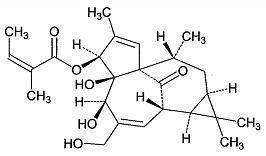
Ingenol mebutate is a white to pale yellow crystalline powder.
Picato® gel, 0.015% and 0.05% contains 150 mcg and 500 mcg of ingenol mebutate, respectively in each gram of gel consisting of isopropyl alcohol, hydroxyethyl cellulose, citric acid monohydrate, sodium citrate, benzyl alcohol and purified water.
Picato® gel is clear colorless gel and supplied in unit dose laminate tubes, for single use, containing a nominal fill weight of 0.47 g, with a deliverable weight of 0.25 g. The tubes should be discarded after single use.
The mechanism of action by which Picato® gel induces cell death in treating AK lesions is unknown.
The pharmacodynamics of Picato® gel is unknown.
The systemic exposure to Picato® gel, 0.05% was assessed in two studies in a total of 16 subjects with AK, following application of approximately 1 g of Picato® gel, 0.05% to an area of 100 cm2 of the dorsal forearm once daily for two consecutive days. In these studies, the blood levels of ingenol mebutate and two of its metabolites (acyl isomers of ingenol mebutate) were measured. Blood levels of ingenol mebutate and the two metabolites were below the lower limit of quantification (0.1 ng/mL) in all the blood samples of the subjects evaluated.
Drug Interactions
In vitro studies demonstrated that [3H]-ingenol mebutate undergoes extensive metabolism in human hepatocytes.
In vitro studies to assess the potential of ingenol mebutate to inhibit or induce human cytochrome P450 (CYP) enzymes demonstrated that ingenol mebutate does not inhibit CYP 1A2, 2A6, 2B6, 2C8, 2C9, 2C19, 2D6, 2E1, and 3A4 or induce CYP 1A2, 2C9, and 3A4. The estimated expected systemic exposure (< 0.1 ng/mL) following topical application of Picato® gel, 0.05% to AK subjects in the pharmacokinetic studies described above is negligible compared to the concentrations of ingenol mebutate evaluated in the in vitro studies.
Long-term animal studies have not been performed to evaluate the carcinogenic potential of Picato ® gel or ingenol mebutate. The effects of ingenol mebutate on fertility have not been evaluated.
Ingenol mebutate was negative in the Ames test, in vitro mouse lymphoma assay, and in vivo rat micronucleus test, but positive in the Syrian hamster embryo (SHE) cell transformation assay.
In two double-blind, vehicle-controlled, clinical trials, 547 adult subjects with AK on the face or scalp were randomized to treatment with either Picato® gel, 0.015% or vehicle gel for 3 consecutive days, followed by an 8 week follow-up period. The studies enrolled subjects with 4 to 8 clinically typical, visible, discrete AK lesions within a 25 cm2 contiguous treatment area. Hypertrophic and hyperkeratotic lesions were excluded from treatment. On each scheduled dosing day, the study gel was applied to the entire treatment area. A total of 536 subjects (98%) completed these studies. Study subjects ranged from 34 to 89 years of age (mean 64 years) and 94% had Fitzpatrick skin type I, II, or III. Approximately 85% of subjects were male, and all Picato®-treated subjects were Caucasian.
Efficacy was assessed at Day 57. Complete clearance rate was defined as the proportion of subjects with no (zero) clinically visible AK lesions in the treatment area. Partial clearance rate was defined as the proportion of subjects with 75% or greater reduction in the number of AK lesions at baseline in the selected treatment area. Table 5 presents the efficacy results for each trial.
|
Table 5 Number and Percent of Subjects Achieving Complete and Partial Clearance at Day 57 in Each Trial |
||||
|
Study 1 |
Study 2 |
|||
|
Picato® gel, 0.015% (N=135) |
Vehicle (N=134) |
Picato® gel, 0.015% (N=142) |
Vehicle (N=136) |
|
|
Complete Clearance Rate |
50 (37%) |
3 (2%) |
67 (47%) |
7 (5%) |
|
Partial Clearance Rate (≥ 75%) |
81 (60%) |
9 (7%) |
96 (68%) |
11 (8%) |
Table 6 presents the response rates by anatomical location for each trial.
|
Table 6 Number and Percent of Subjects Achieving Complete Clearance at Day 57 by Anatomical Location and by Trial |
||||
|
Study 1 |
Study 2 |
|||
|
Picato® gel, 0.015% (N=135) |
Vehicle (N=134) |
Picato® gel, 0.015% (N=142) |
Vehicle (N=136) |
|
|
Scalp |
4/26 (15%) |
0/25 (0%) |
9/31 (29%) |
1/25 (4%) |
|
Face |
46/109 (42%) |
3/109 (2%) |
58/111 (52%) |
6/111 (5%) |
Subjects who achieved complete clearance at Day 57 in Study 1 and Study 2 entered a 12-month follow-up period. Based on 108 Picato® gel-treated subjects who achieved complete clearance in Study 1 and Study 2, the recurrence rate at 12 months was 54% where recurrence was defined as the percentage of subjects with any identified AK lesion in the previously treated area who achieved complete clearance at Day 57.
In two double-blind, vehicle-controlled clinical trials, 458 adult subjects with AK on the trunk or extremities were randomized to treatment with either Picato® gel, 0.05% or vehicle gel for 2 consecutive days, followed by an 8 week follow-up period. The studies enrolled subjects with 4 to 8 clinically typical, visible, discrete AK lesions within a 25 cm2 contiguous treatment area. Hypertrophic and hyperkeratotic lesions were excluded from treatment. On each scheduled dosing day, the study gel was applied to the entire treatment area. A total of 447 subjects (98%) completed these studies. Study subjects ranged from 34 to 89 years of age (mean 66 years) and 94% had Fitzpatrick skin type I, II, or III. Approximately 62% of subjects were male, and all Picato®-treated subjects were Caucasian.
Efficacy was assessed at Day 57. Complete clearance rate was defined as the proportion of subjects with no (zero) clinically visible AK lesions in the treatment area. The partial clearance rate was defined as the proportion of subjects with 75% or greater reduction in the number of AK lesions at baseline in the selected treatment area. Table 7 presents the efficacy results for each study.
|
Table 7 Number and Percent of Subjects Achieving Complete and Partial Clearance at Day 57 in Each Trial |
||||
|
Study 3 |
Study 4 |
|||
|
Picato® gel, 0.05% (N=126) |
Vehicle (N=129) |
Picato® gel, 0.05% (N=100) |
Vehicle (N=103) |
|
|
Complete Clearance Rate |
35 (28%) |
6 (5%) |
42 (42%) |
5 (5%) |
|
Partial Clearance Rate (≥ 75%) |
56 (44 %) |
9 (7 %) |
55 (55 %) |
7 (7 %) |
Table 8 presents the response rates by anatomical location for each study.
|
Table 8 Number and Percent of Subjects Achieving Complete Clearance at Day 57 by Anatomical Location and by Trial |
||||
|
Study 3 |
Study 4 |
|||
|
Picato® gel, 0.05% (N=126) |
Vehicle (N=129) |
Picato® gel, 0.05% (N=100) |
Vehicle (N=103 ) |
|
|
Arm |
22/84 (26 %) |
4/82 (5 %) |
27/59 (46 %) |
3/67 (5 %) |
|
Back of Hand |
4/25 (16 %) |
0/29 (0%) |
6/28 (21 %) |
0/27 (0 %) |
|
Chest |
8/9 (89 %) |
1/8 (13 %) |
3/5 (60 %) |
1/3 (33 %) |
|
Othera |
1/8 (13 %) |
1/10 (10 %) |
6/8 (75 %) |
1/6 (17 %) |
aOther includes shoulder, back, leg.
Subjects who achieved complete clearance at Day 57 in Study 4 entered a 12-month follow-up period. Based on 38 Picato® gel-treated subjects who achieved complete clearance in Study 4, the recurrence rate at 12 months was 50% where recurrence was defined as the percentage of subjects with any identified AK lesion in the previously treated area who achieved complete clearance at Day 57.
Picato® gel is a clear colorless gel and is supplied in unit dose laminate tubes containing a nominal fill weight of 0.47 g, with a deliverable weight of 0.25 g. The tubes should be discarded after single use.
Picato® gel is available in 2 dosage strengths: 0.015% and 0.05%.
| Dosage Strength | Number of unit dose tubes per carton | NDC# |
|---|---|---|
| 0.015 % | 3 | 50222-502-47 |
| 0.05 % | 2 | 50222-503-47 |
Store Picato® gel in a refrigerator at 36ºF – 46ºF (2ºC – 8ºC); excursions permitted between 32ºF – 59ºF (0ºC – 15ºC) (see USP for controlled cold temperature). Protect from freezing.
“See FDA-approved patient labeling (Patient Information and Instructions for Use)”
Picato® gel should be used as directed by a physician.
Picato® gel is for external use only. Advise patients to avoid contact with the eyes. Inform patients that treatment with Picato® gel may lead to local skin reactions [see Warnings and Precautions (5)].
Patients should avoid inadvertent transfer of Picato® gel to other areas, or to another person. Instruct patients to:
- allow the treated area to dry for 15 minutes after application.
- avoid washing and touching the treated area, or participating in activities that cause excessive sweating, for 6 hours after treatment. Following this time, patients may wash the area with a mild soap.
- keep out of the reach of children.
Patient Information: PICATO® [Pih-KAY-toe] (ingenol mebutate) gel 0.015%, 0.05%
Important: For use on the skin only (topical). Do not use Picato® gel in or on your eyes, mouth, or vagina.
Read the Patient Information leaflet that comes with Picato® gel before you start using it and each time you get a refill. There may be new information. This leaflet does not take the place of talking with your healthcare provider about your medical condition or treatment. If you do not understand the information, or have any questions about Picato® gel, talk with your healthcare provider or pharmacist.
What is Picato® gel?
Picato® gel, 0.015% is a prescription medicine used on the skin to treat actinic keratosis on the face and scalp.
Picato® gel, 0.05% is a prescription medicine used on the skin to treat actinic keratosis on the body, arms, and legs.
It is not known if Picato® gel is safe and effective for the treatment of actinic keratosis in children less than 18 years of age.
What should I tell my healthcare provider before using Picato® gel?
Before you use Picato® gel, tell your healthcare provider if you:
- are being treated or have been treated for actinic keratosis with other medicines or surgery. You should not use Picato® gel until your skin has healed from other treatments.
- have other skin problems or sunburn in the treatment area.
- have any other medical conditions.
- are pregnant or plan to become pregnant. It is not known if Picato® gel can harm your unborn baby.
Tell your healthcare provider about all the medicines you take, including prescription and non-prescription medicines, vitamins and herbal supplements. It is not known if Picato® gel and other medicines can affect each other. Tell your healthcare provider if you have had other treatments for actinic keratosis. You should not use Picato® gel until your skin has healed from other treatments.
How should I use Picato® gel?
- Use Picato® gel exactly as your healthcare provider tells you. Picato® gel is for skin use only.
- Your healthcare provider will tell you where to apply Picato® gel, and how often, and how long to apply it. Do not apply Picato® gel to other areas.
- Do not use more Picato® gel than you need to cover the treatment area. Using too much Picato® gel, or using it too often, or too long can increase your chances for having a severe skin reaction or other side effects.
- Do not get Picato® gel in your eyes. Do not touch your eyes while you are applying Picato® gel. Wash your hands well with soap and water after applying Picato® gel. After applying Picato® gel, be careful to keep Picato® gel on the treated area from coming into contact with your eyes. Irritation may happen if you get Picato® gel in your eyes. If you accidentally get Picato® gel in your eyes, flush them with large amounts of water and get medical care as soon as possible. Also see “What are the possible side effects of Picato® gel?"
- Do not get Picato® gel in your mouth.
- Only use a tube of Picato® gel 1 time. Throw away any open tube of Picato® gel after use even if there is medicine still left in it.
- See the Instructions for Use that comes with your Picato® gel for information about the right way to apply it.
What should I avoid while using Picato® gel?
- Do not cover the treated site with bandages or other closed dressings.
What are the possible side effects of Picato® gel?
PICATO® gel may cause severe side effects including:
- Eye problems can happen if Picato® gel gets in your eyes. Eye problems may include severe eye pain, swelling or drooping of your eyelids, or swelling around your eyes. If you accidentally get Picato® gel in your eyes, flush them with large amounts of water and get medical care as soon as possible.
- Local skin reactions. Skin reactions in the treatment area are common with Picato® gel. You may get a skin reaction such as mild redness, flaking or scaling, crusting, or swelling. Call your healthcare provider if you get skin redness, flaking or scaling, crusting, or swelling that is more severe, or if you get blisters, pus, ulcers or breakdown of your skin.
The most common side effects with Picato® gel include:
- “local skin reactions,” see above
- pain, itching, or skin irritation at the treatment area
- infection at the treatment area
- nose and throat irritation
- headache
Tell your healthcare provider if you have any side effect that bothers you or that does not go away.
These are not all the side effects of Picato® gel. For more information, ask your healthcare provider or pharmacist.
Call your doctor for medical advice about side effects. You may report side effects to FDA at 1-800-FDA-1088.
You may also report side effects to LEO Pharma Inc. at 1-877-494-4536.
How do I store Picato® gel?
- Store Picato® gel in a refrigerator at 36ºF to 46ºF (2ºC to 8ºC). Do not freeze.
- Safely throw away used Picato® gel tubes in household trash.
Keep Picato® gel and all medicines out of the reach of children.
General information about Picato® gel.
Medicines are sometimes prescribed for purposes other than those listed in a Patient Information leaflet. Do not use Picato® gel for a condition for which it was not prescribed. Do not give Picato® gel to other people, even if they have the same symptoms you have. It may harm them.
This Patient Information leaflet summarizes the most important information about Picato® gel. If you would like more information, talk with your healthcare provider. You can ask your pharmacist or healthcare provider for information about Picato® gel that is written for healthcare professionals.
What are the ingredients in Picato® gel?
Active ingredient: ingenol mebutate.
Inactive ingredients: isopropyl alcohol, hydroxyethyl cellulose, citric acid monohydrate, sodium citrate, benzyl alcohol and purified water.
This Patient Information has been approved by the U.S. Food and Drug Administration.
Manufactured by
LEO Laboratories Ltd. (LEO Pharma)
285 Cashel Road,
Dublin 12
Ireland
or
DPT Laboratories, Ltd.
307 E. Josephine Street
San Antonio, TX 78215, USA
Distributed by
LEO Pharma Inc.
1 Sylvan Way, Parsippany, NJ 07054, USA
1-877-494-4536
Issued January 2012
US Patent Nos. US6432452, US6787161
Copyright LEO Laboratories Ltd., January 2012
Be sure that you read, understand, and follow these Instructions for Use before you use Picato® gel for the first time. Also read the Patient Information leaflet that comes with Picato® gel.
Important:
- Always use Picato® gel exactly as your healthcare provider tells you. Check with your healthcare provider or pharmacist if you are not sure.
- Only use Picato® gel, 0.05% to treat actinic keratosis on your body, arms, hands and legs.
- Apply Picato® gel, 0.05% to the skin area to be treated 1 time each day for 2 days in a row. Use a new tube for each day of treatment.
- Avoid touching the treatment area or doing activities that cause a lot of sweating for 6 hours after applying Picato® gel. After 6 hours you may wash the treatment area with a mild soap and water.
Do not:
- apply right after taking a shower or less than 2 hours before bedtime.
- cover the treated area with bandages or other dressings after you have applied Picato® gel.
- get Picato® gel in your eyes. Do not touch your eyes while you are applying Picato® gel. Wash your hands well with soap and water after applying it. After applying Picato® gel, be careful to keep Picato® gel on treated area from coming into contact with your eyes. Irritation may happen if you get Picato® gel in your eyes. If you accidentally get Picato® gel in your eyes, flush them with large amounts of water and get medical care as soon as possible. Also see the section of Patient Information leaflet section called “What are the possible side effects of Picato® gel?”
Applying Picato® gel.
Step 1. Open a new tube each time you use Picato® gel.
Step 2. Remove cap from tube just before use. (See Figure A.)
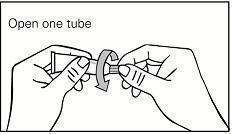
Figure A
Step 3. Squeeze the gel from the tube onto a fingertip. (See Figure B.) Only use enough gel needed to cover the affected area, as directed by your healthcare provider. One tube contains enough gel to cover a skin area of about 2 inches by 2 inches.
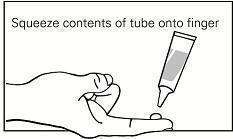
Figure B
Step 4. Spread the gel evenly over only the skin area to be treated. Allow the treated area to dry for 15 minutes. (See Figure C.)
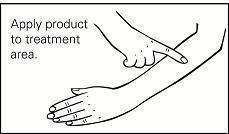
Figure C
Step 5. Wash your hands right away after applying Picato® gel. (See Figure D.) If you are treating your hands you should only wash the fingertip which you used for applying the gel.
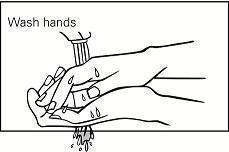
Figure D
Step 6. Safely throw away (dispose of) the tube after use.
Repeat the above steps for each day of treatment.
How should I store Picato® gel?
- Store Picato® gel in a refrigerator at 36ºF to 46ºF (2ºC to 8ºC). Do not freeze.
- Picato® gel has an expiration date (exp) marked on the end of the tube. Do not use the gel after this date.
- Safely throw away used Picato® gel tubes in household trash.
This Instructions for Use has been approved by the U.S. Food and Drug Administration.
Manufactured by
LEO Laboratories Ltd. (LEO Pharma)
285 Cashel Road,
Dublin 12
Ireland
or
DPT Laboratories, Ltd.
307 E. Josephine Street
San Antonio, TX 78215, USA
Distributed by
LEO Pharma Inc.
1 Sylvan Way, Parsippany, NJ 07054, USA
1-877-494-4536
Issued January 2012
Be sure that you read, understand, and follow these Instructions for Use before you use Picato® gel for the first time. Also read the Patient Information leaflet that comes with Picato® gel.
Important:
- Always use Picato® gel exactly as your healthcare provider tells you. Check with your healthcare provider or pharmacist if you are not sure.
- Only use Picato® gel, 0.015% to treat actinic keratosis on your face and scalp.
- Apply Picato® gel, 0.015% to the skin area to be treated 1 time each day for 3 days in a row. Use a new tube for each day of treatment.
- Avoid touching the treatment area or doing activities that cause a lot of sweating for 6 hours after applying Picato® gel. After 6 hours you may wash the treatment area with a mild soap and water.
Do not:
- apply right after taking a shower or less than 2 hours before bedtime.
- cover the treated area with bandages or other dressings after you have applied Picato® gel.
- get Picato® gel in your eyes. Do not touch your eyes while you are applying Picato® gel. Wash your hands well with soap and water after applying it. After applying Picato® gel, be careful to keep Picato® gel on the treated area from coming into contact with your eyes. Irritation may happen if you get Picato® gel in your eyes. If you accidentally get Picato® gel in your eyes, flush them with large amounts of water and get medical care as soon as possible. Also see the section of Patient Information leaflet section called “What are the possible side effects of Picato® gel?”
Applying Picato® gel.
Step 1. Open a new tube each time you use Picato® gel.
Step 2. Remove cap from tube just before use. (See Figure A.)
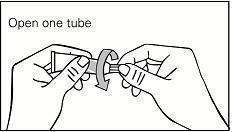
Figure A
Step 3. Squeeze the gel from the tube onto a fingertip. (See Figure B.) Only use enough gel needed to cover the affected area, as directed by your healthcare provider. One tube contains enough gel to cover a skin area of about 2 inches by 2 inches.

Figure B
Step 4. Spread the gel evenly over only the skin area to be treated. Allow the treated area to dry for 15 minutes. (See Figure C.)

Figure C
Step 5. Wash your hands right away after applying Picato® gel. (See Figure D.)
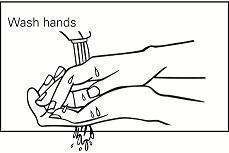
Figure D
Step 6. Safely throw away (dispose of) the tube after use.
Repeat the above steps for each day of treatment.
How should I store Picato® gel?
- Store Picato® gel in a refrigerator at 36ºF to 46ºF (2ºC to 8ºC). Do not freeze.
- Picato® gel has an expiration date (exp) marked on the end of the tube. Do not use the gel after this date.
- Safely throw away used Picato® gel tubes in household trash.
This Instructions for Use has been approved by the U.S. Food and Drug Administration.
Manufactured by
LEO Laboratories Ltd. (LEO Pharma)
285 Cashel Road,
Dublin 12
Ireland
or
DPT Laboratories, Ltd.
307 E. Josephine Street
San Antonio, TX 78215, USA
Distributed by
LEO Pharma Inc.
1 Sylvan Way, Parsippany, NJ 07054, USA
1-877-494-4536
Issued January 2012
NDC 50222-503-47
Rx only
Picato®
(ingenol mebutate) gel
0.05%
For Topical Use on Trunk and Extremities Only
Not for Oral, Ophthalmic, or Intravaginal Use
2 Unit Dose Tubes
Net Wt. 0.47 g in each tube
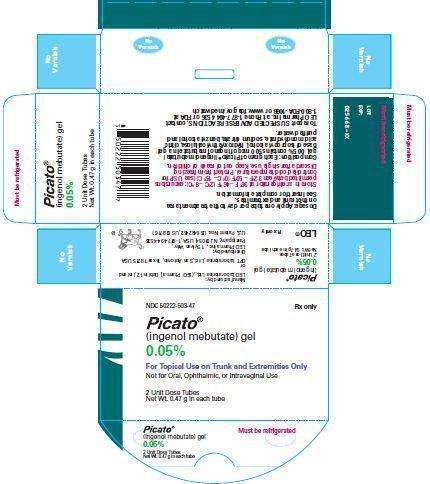
Principal Display Panel for PICATO [Pih-KAY-toe] (ingenol mebutate) gel 0.015%
NDC 50222-502-47
Rx only
Picato®
(ingenol mebutate) gel
0.015%
For Topical Use on Face and Scalp Only
Not for Oral, Ophthalmic, or Intravaginal Use
3 Unit Dose Tubes
Net Wt. 0.47 g in each tube
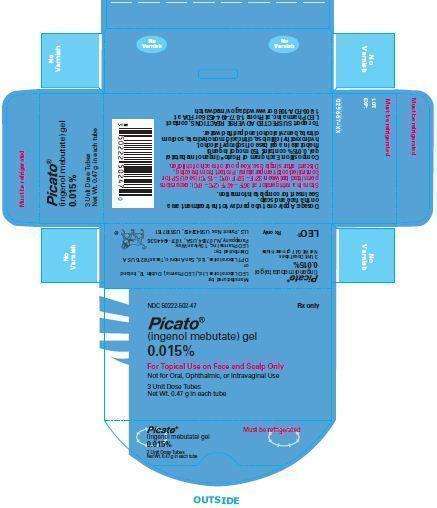
Principal Display Panel for PICATO [Pih-KAY-toe] (ingenol mebutate) gel 0.015% Physician Sample
NDC 50222-502-91
Rx only
Picato®
(ingenol mebutate) gel
0.015%
For Topical Use on Face and Scalp Only
Not for Oral, Ophthalmic, or Intravaginal Use
3 Unit Dose Tubes
Net Wt. 0.47 g in each tube
Physician's Sample - Not For Sale
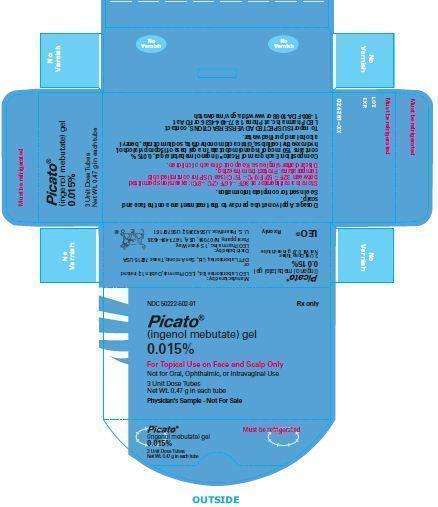
Picatoingenol mebutate GEL
| ||||||||||||||||||||||||||||||||||||||||||||||||||||||||||||||||||||||||||||
Picatoingenol mebutate GEL
| |||||||||||||||||||||||||||||||||||||||||||||||||||||||||||||||||||||||